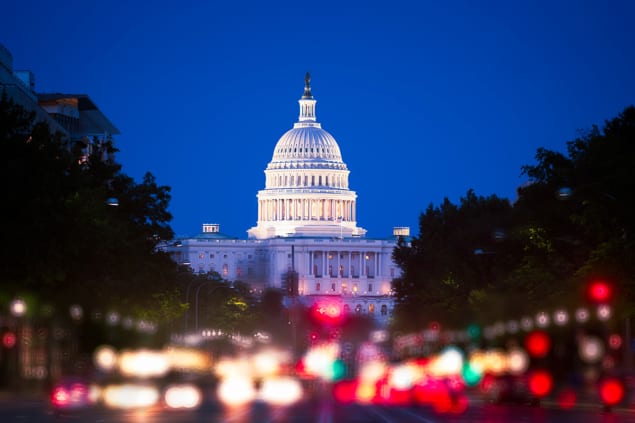Attention has focused on Green New Deal but not everyone concurs on principles for crafting climate legislation, says Dave Elliott

After falling slightly for a time, overall greenhouse gas emissions in the US have started to rise again and there have been job losses, as Trump’s policies have hit solar. With that as a backdrop, much attention has been focused on the Green New Deal proposed by Representative Alexandria Ocasio-Cortez and other Democrats, which called for a shift to 100% renewables. Quite a big ask.
However, there have been some issues. Seeking to push matters ahead, 626 organizations, mostly environmental groups – including 350.org and Greenpeace USA – sent a letter to the US Congress urging lawmakers to consider a number of principles when crafting climate legislation like that outlined in the proposed Green New Deal, “to keep global warming below 1.5 degrees C”. As it stood initially, the Green New Deal proposal looked to “meeting 100% of the power demand in the US through clean, renewable, and zero-emission energy sources”. But it didn’t say when, or how, or exactly which sources were included. Toughening the deal, the green lobby group letter called for, among other things, a phase-out of all fossil-fuel extraction and a transition in power generation to 100% renewable energy “by 2035 or earlier”, with nuclear, large hydro and biomass/waste combustion ruled out. Quite a radical exclusion list.

Can we get to net zero emissions?
It was all too much for eight major US environmental groups, including the Sierra Club, the Natural Resources Defense Council, and the Environmental Defense Fund, who declined to sign the letter. It seems they took exception to some of the details. For example, the letter states, “in addition to excluding fossil fuels, any definition of renewable energy must also exclude all combustion-based power generation, nuclear, biomass energy, large scale hydro and waste-to-energy technologies”. It also said “we will vigorously oppose any legislation that … promotes corporate schemes that place profits over community burdens and benefits, including market-based mechanisms and technology options such as carbon and emissions trading and offsets, carbon capture and storage, nuclear power, waste-to-energy and biomass energy.”
So no market-based carbon tax or cap and trade systems; instead direct government regulation and intervention. A hard-line leftish view. Even the otherwise progressive Grist ran an article saying “to meet climate targets, we need every tool in the chest”, including nuclear and a carbon tax, which would presumably support it, at least to the extent that nuclear is low-carbon. Climate science pioneer James Hansen also, it seems, backs a carbon tax and a slower more incremental approach, including nuclear. Interesting then to see that, while public US views are reportedly split 50/50 on nuclear, there is generally more public backing for direct support for renewables (83%), as opposed to carbon taxes (47%), though the latter evidently appeals to some market-orientated economists and even to some greens.
Too aggressive?
The “100% renewable by 2035” target backed by the radicals would certainly be tough, especially so with no new nuclear, hydro or biomass. Some hydro is useful, for balancing variable renewables: there are plans to convert the 2 GW Hoover dam into a pumped storage project. Some biomass aerobic digestion is useful too, using wastes especially. Better than letting them rot in the air or in uncapped landfill sites. A bit of a rethink on those exclusions may be needed. But, although one new nuclear plant is being built with heavy subsidies (it recently benefited from an extra $3.7 bn Federal loan guarantee), nuclear is being killed off in the US by cheaper alternatives. So if that is what you agree with, arguably it hardly needs to be a major campaign focus, apart from pointing out that it is not a carbon-free option in case that wasn’t clear, and also resisting last-ditch attempts to provide emergency subsidies to keep a few old plants going.
That said, it is odd that the usually very progressive US Union of Concerned Scientists (UCS) has been backing interim support for some old nuclear plants. Steve Clemmer, its director of energy research, said “losing a low-carbon source of electricity like nuclear power is going to make decarbonization even harder than it already is. Nuclear has risks, it’s not a perfect technology, but there have to be trade-offs”. So UCS looked at the case for public subsidies to keep some nuclear plants going a bit longer. Not something most radical greens would be likely to support.

Global energy in 2050 – can renewables supply it all?
Commenting on the UCS report M V Ramana from the University of British Columbia, Canada, said that it was basically “a plea to keep the nuclear industry on life support by states providing subsidies to nuclear power plants that are not profitable”. However, he said the report did insist on some new rules, including a requirement that plant owners open their financial books and demonstrate need, and periodically assess whether continued support was necessary and cost-effective. He felt that “these requirements are not easy to meet”.
Ramana also noted that the old plants were likely to be replaced with renewables, not with fossil fuel, as UCS seemed to think. Maybe what’s needed, if campaigners are talking about transitional demands, is a formal requirement for that to be included as part of an agreed early-closure plan before being offered any sort of interim support.
Looking at the overall strategic debate on energy, it could be argued that, if you want to change an entrenched system, maximalist programmes may be unwise — they may just be ignored. Some “red lines” will no doubt always remain (it’s unlikely that the radical greens will want to compromise on nuclear, or back carbon trading/market approaches), but on the rest, maybe it is better to set priorities and a transitional programme.
Progress continues
The Green Deal bid took a hit in its first attempt but will no doubt reappear as the US Presidential election battles ramp up. While the politics gets thrashed out, technological and project progress continues, with renewables at over 245 GW and booming as costs fall. Wind, at over 94 GW so far, and PV solar, at over 50 GW, are now seen as clearly economically competitive with coal. Onshore wind is doing well, supplying 6.3% of US electricity overall and more than 10% of total electricity generation in 14 states — over 30% in Iowa, Kansas, Oklahoma, and South Dakota in 2017. It’s also proving to be popular, with a survey finding strong local support.
Onshore wind seems likely to continue to boom; there’s 35 GW more in the pipeline. The Department of Energy says the national average price of wind Power Purchase Agreements fell to ~2¢/kWh, and looks to capacity additions of 8000 — 11,000 MW/yr from 2018 to 2020 but market contraction is likely from 2021 as tax incentives are phased out. Despite Trump’s cuts, solar is also doing well, with over 188.5 GW of utility-scale PV projects in the pipeline by the end of 2017 and, in all, over 1.3 million distributed systems. A massive and continuing surge. It may be further boosted by California’s 100% clean power goal. The state aims to get 60% of retail electricity from renewables by 2030 and 100% by 2045.
Next up, after a long delay and some local political opposition, offshore wind is finally taking off in the US. According to the Department of Energy, the US now has a project pipeline of more than 25 GW of capacity, with nearly 2 GW expected to be in place by 2023, to follow up the 30 MW already installed. Almost all the expansion is set to be on the Eastern seaboard, spread across just a handful of states, led by Massachusetts, which has 11 bids in progress. Meanwhile, solar technology continues to develop. Looking further ahead, there has been something of an MIT-led “sun in a box” energy storage breakthrough. This uses molten silicon, heated via solar or other energy sources, to store energy and then generate power with photovoltaics run off its while hot glow.
Looking even further ahead, there has been a proposal for a North America–Europe subsea power grid link. But the shortest/easiest route would be from Canada to the UK…what would the US, and the EU, make of that? Even more fascinating, and geopolitically challenging, there is a new study of a North–South America supergrid interlink, which I will look at in my next post. An end to isolationism?



